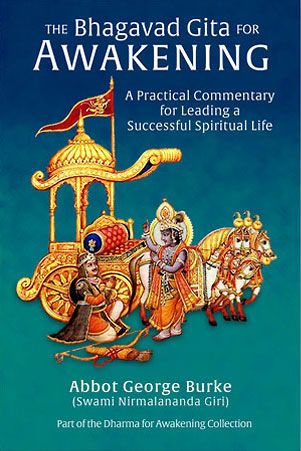
The One in all
Krishna now concludes the subject of the field and the knower of the field, pointing out the results of seeing their nature and their union.
Know this: whatever is born, the animate or the inanimate, know it to be resulting from the union of the Field and the Knower of the Field (13:26).
All that exists within the field of relativity, even if only momentarily, has arisen from the interaction of the field (prakriti) and the knower of the field (purusha), that are really one and the same. For “creation” is a dream of the purusha, though infinitely more stable and lasting than our nightly dreams.
Regarding those who wake from the cosmic dream, Krishna says:
He who sees the Supreme Lord existing in all beings equally, not dying when they die–he sees truly (13:27).
What a glorious vision! And Krishna uses the term Parameshwara–Supreme Lord–for he is speaking of a very personal seeing of God, not some abstract metaphysical Principle. God is indeed Principle, but so much more besides. To ever see God, to not have the world be a veil but a window, is possible to the yogi, a sublime possibility. For such a one: “Death is swallowed up in victory” (I Corinthians 15:54).
The One in him
Truly seeing the same Lord existing everywhere, he injures not the Self by the lower self. Then he goes to the Supreme Goal (13:28).
Unpleasant as the fact may be, people live in continual violation of their spirit-nature. Daily they outrage their divine Self in a multitude of ways, all of which have the single effect of burying, even suffocating, their Self, of dethroning and degrading it–at least within this plane of relative existence, even though the Self can never be diminished or harmed in the transcendental realm. The way human beings live is a kind of constant attempted murder of their own deathless being. This is a terrible mode of life, and the world around us reveals the results.
Although nearly all of the world continues to repeat the same deadly folly, we as individuals need not do so. We can make our heart and our home a haven of peace, an abode of Consciousness. It is all a matter of refining and elevating our usual state of mind through japa and meditation, of thus “truly seeing the same Lord existing everywhere” around us. Freed from the lie of ego, we come to know who and what we really are, and our eternal relationship with God.
He who himself sees thus: that all actions are performed exclusively by Prakriti, and perceives that therefore he is himself not the doer–he sees truly (13:29).
In the midst of “change and decay all around I see,” the yogi is undisturbed, because he knows that prakriti alone is moving, changing, breaking up, and recombining–that the Self is untouched by all that, the unmoving witness of it all. As Yogananda continually reminded his students, “this is all just movies.” The movie is not ultimately real, but the movie-viewers are. And when the show is over they will leave the theater and go home where they belong without a backward look.
When he perceives the various states of being as resting in the One, and their expansion from that One alone–he then attains Brahman (13:30).
First we see the truth of the individual Self, and then we are enabled to know the Supreme Self. All states and forms of existence come from Brahman and ever remain within Brahman. The entire cosmos is a great ritual of Consciousness. As the fourth chapter says: “Brahman is the offering, Brahman is the oblation poured out by Brahman into the fire of Brahman. Brahman is to be attained by him who always sees Brahman in action.” This being so:
This eternal Supreme Self, without beginning and devoid of gunas, even though dwelling in the body, does not act, nor is it tainted. As the all-pervading ether because of its subtlety is not tainted, so the Self seated in the body is not tainted at any time in any situation. As the sun alone illumines this entire world, so the Lord of the field illumines the entire field. Those who know through the eye of knowledge the distinction between the Field and the Knower of the Field, and the liberation of beings from Prakriti–they go to the Supreme (the Highest) (13:31-34).
This is no intellectual exercise, but “knowledge combined with realization” (9:1). Once we know the difference between purusha and prakriti, and how to distance ourselves from the prakriti-dream, we are on the way to freedom from bondage in this or any other world.
Read the next article in the Bhagavad Gita for Awakening: The Three Gunas







